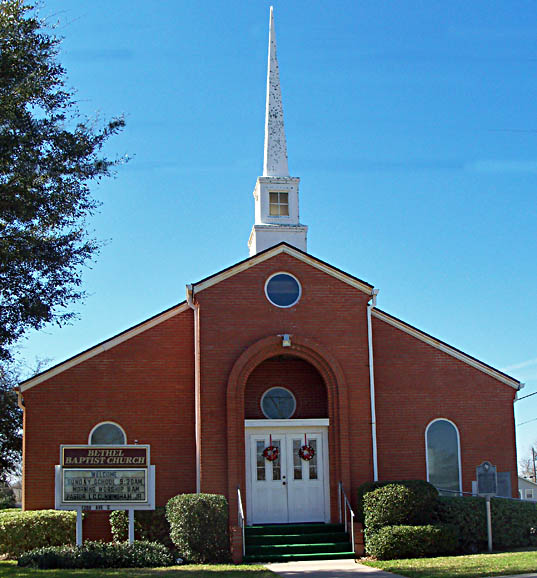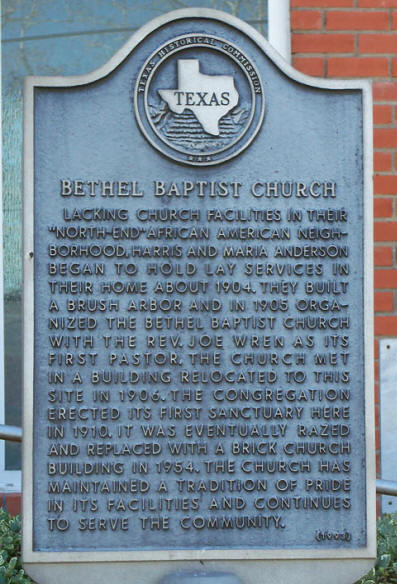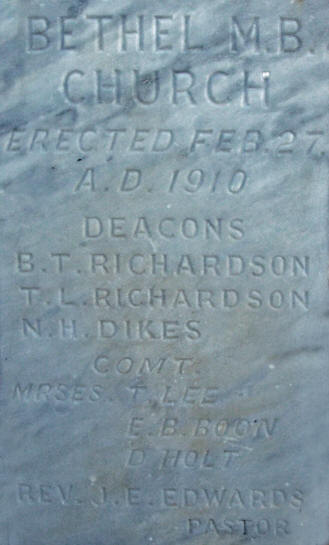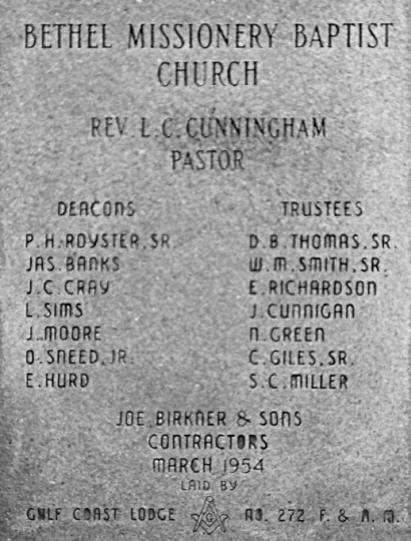|
Bethel Baptist Church
1200 Avenue C
28°59'31.24"N 95°58'27.37"W |
||||||||||||||||||||||||||||||||||||||||||||||||
|
||||||||||||||||||||||||||||||||||||||||||||||||
|
Written by Thelma D. Brown Smith A desire to found a church at the present site, 1200 Avenue C, Bay City, Texas, was visualized in the year of 1904. There was no central place in this section of town where Negro people could worship, except in the home. From 1904 to today, that idea became a reality. In October 1894, Bay City became a townsite and the county seat for Matagorda County. The town subdivisions had been outlined, bought, and laid out. Land was for sale. D. P. Moore's First Addition encompassed what is now 13th Street-South to Grace Street-North, and Avenue F-East, to Moore Street-West. Negro people began to purchase land from 13th Street-South to Grace Street-North, and from Avenue E-West to Moore Street-East. This section of the subdivision was given the general name, North-end. Another subdivision farther south was called South-end. In the late 1800's, Negroes had begun to leave the rural areas in Matagorda County, moving to Bay City. While in the rural areas, many owned farm land, but lacked the economic means to farm. They were searching for better schooling for their children as well as for resources that could aid them in having a better way of life. Several families bought and lived in the North-end section of town; however, to worship, they had to walk to South-end or travel by horse and wagon back to the rural churches. They had to travel trails or mud-caked paths to get to church, but this did not deter their determination. Their desire and enthusiasm ran high because they were accustomed to attending church services. This was a way of life. They could find solace and join with others in giving praise and adoration to the heavenly being. Determined to have a better life, Harris Anderson, Sr., a farmer on Caney, purchased land in North-end. Upon gathering his crop in 1904, Anderson with his wife, Maria Louisiana, and five of their children, Pearl, Harris, Jr., Gertrude, J. P., and Campbell, moved to Bay City. Three of their children, Ida, William, and Sheppard, were grown and away from home on their own. The baby, Ethel, had not been born. Ethel Anderson Jones says that her parents were in a hurry to move to Bay City because the time was approaching for her mother to have her. Before moving to Bay City, the Andersons were faithful, devoted members of Berean Baptist Church which was located on Buckner Prairie in the Cedar Lane area. The Andersons noticed that the nearest church they could attend was in South-end. They visualized a church in North-end. They tried to inspire their neighbors to found a church in North-end, but to no avail. Many excuses were offered, and Taylor Richardson, the spokesman for the people, said it couldn't be done. The Andersons did not give up. They held church in their home when it was inconvenient for them to go elsewhere. In the summer of 1905, Harris Anderson, Sr., using his mules and wagon, hauled brush and poles from his mother's property on Caney to the North-end area of Bay City. (His mother's property was located in an area called Bowie.) After he had hauled enough brush and poles for an arbor, he went to the Sutherland/Alamo Lumber Company to obtain permission to erect the arbor. He stated that they were attempting to build an arbor for a place to worship, and that if they were successful, they would purchase the land on which it stood. With permission granted, and using his own money, Anderson purchased other materials from the lumber company to construct the arbor. Anderson, his wife, and son, Harris, Jr., erected the frame-work and completed the arbor. The Andersons, their three older children, Taylor Richardson, and Berry Lipskins met under the arbor and organized the church. Harris Anderson, Sr., selected the name Bethel Baptist Church for the church. Officers of the church were: Harris, Sr., Deacon and superintendent of the Sunday School; Maria Louisiana, president of the Missionary Society; Harris, Jr., secretary; and Harris, Sr., Taylor Richardson, and Berry Lipskins, trustees. The Rev. Joe Wren was the church's first pastor. Charity Richardson, wife of Taylor, and Anna Lipskins, wife of Berry, became members of the church. Every Saturday night, Maria Anderson sold homemade ice cream, fish, and chili under the arbor to raise funds to buy the property on which the arbor stood. She also contacted many white families in Bay City for donations to help the church. Church dues were 25 cents per month. The church under the arbor grew in membership and finances. On July 26, 1906, Taylor Richardson and Harris Anderson, Sr., Trustees for Bethel Baptist Church, purchased Lots 7 and 8, Block 14, of the D. P. Moore's First Addition to Bay City, Texas. Said lots have an east frontage of 50 feet each facing Avenue C; a total of 100 feet each abutting Grace Street, and a total of 140 feet with a 20‑foot space left for the street and alley. The property was bought at a cost of $30 for the two lots. After acquiring the property, the people began to think about a frame building for the church. The arbor had served its purpose. A small church building was for sale in the east end of town near the Sante Fe Railroad depot. Through arrangements with the Sutherland/Alamo Lumber Company, the people purchased the building and moved it to the church property in North-end. Shortly after, Taylor Richardson and Berry Lipskins were ordained as deacons for the church. The Rev. Wren served as pastor of Bethel Church for about three years, 1905 to 1908. Two Sundays out of the month, he pastored the Bethel Church; the other two Sundays, he pastored the Berean Baptist Church on Buckner Prairie in the Cedar Lane area. Some of the people that united with the Bethel Church under the administration of the Rev. Wren were: Frank and Ellen Washington; Dave and Lou Alexander; Bill and Jennie Carter; Gentle and Ada Gardner; Rev. Willie Jenkins and wife, Carrie; Rev. Warner Robinson and wife, Lettie; Rev. Daisy Jones and wife, Ella; Rebecca and Sally Jenkins; Precilla and Addie Royster; Ellen Richardson; Mary Hubbard; Sisly Duggard; Sedonia Holt; Jane Fields; Nancy Duggard; Agrelia Williams; and Horace Robinson. A disagreement arose in the church and the "right hand" fellowship was withdrawn from Harris Anderson, Sr. He and his family withdrew from Bethel Baptist Church and moved their membership to Mother Zion Baptist Church in South-end. They were not satisfied at Mother Zion, so Harris, his wife, Maria, and several other persons left Mother Zion and founded what is now known as Enterprise Baptist Church in 1909. Later Harris returned to Mother Zion. His wife, Maria, and the Anderson children returned to Bethel. The following persons pastored the Bethel Baptist Church: Rev. Wren, Rev. Joe E. Edwards (1910), Rev. A. C. Ray (1918), Rev. C. H. Jones, Rev. H. L. Body, Rev. A. C. King (died shortly), Rev. H. L. Body (second term), Rev. C. P. Clay, Rev. J. T. Tolbert, and Rev. L. C. Cunningham (October 22, 1946). As of this writing (1992), all of the former pastors are deceased, except Cunningham. He is the present pastor for the Bethel Church. (Editor's Note: The Rev. L. C. Cunningham, Sr., is now deceased and the Rev. L. C. Cunningham, Jr., is pastor of Bethel Baptist Church.) Under Rev. Edwards' administration, Clarence Williams was the church's secretary and Cornelius Abrams, the treasurer. The Deacons were B. T. Richardson, T. Richardson, and N. Dykes. Persons uniting with the church were B. T. and Delia Richardson (school teachers who moved from Linville and Mt. Pilgrim Church), Alice Harris (county home demonstration agent), Nora and Anna Dykes, and Brother Haines and wife, Patience.
In 1910, a new church building was erected on Lot 8. Rev. Edwards resigned in 1918, and Rev. Ray became the pastor. After being at the church for a time, he married a local school teacher, Lucy White. They organized the first choir in the church. Uniting with the church were: Ethel and Campbell Anderson, Henry Hurley Edison (Lipskins' stepson), Roosevelt, Blanche and Elijah Richardson. These were all the children of the founders of Bethel Baptist Church. At the present (1992), Ethel and Nathan Green are the only living ones left to tell the story. The 1910 building was a long wood-framed structure with three front entrances. The side two entrances recessed into ante rooms, before entering into the main sanctuary. The direct front entrance had double doors that opened into the main sanctuary. An aisle ran down the center of the church. Slatted pews were on each side of the aisle. Behind the pulpit area was a choir rostrum, with doors leading off each side to a pastor's study on the right and a choir room on the left. A bell tower with a bell was located on top of the building. The rope to ring the bell hung down in the ante room. This building served as the Bethel Baptist Church until 1962. From September 1945 to May 1948, the Bethel Church building was used as a classroom for the Hilliard High School second grade class. There were too many children in those classes to be housed on the Hilliard campus; therefore, the Bay City Independent School District Administration secured the use of the Bethel Church building. Mrs. Hilda B. Francis, the teacher for the second grade classes, had to improvise to properly instruct the children during the day. The children got on their knees and used the seats of the slatted pews as desks. They either brought sack lunches or were led over to the Hilliard campus cafeteria for lunch. Water was outside, and an outhouse near the alley served as toilet facilities. The custodian from the Hilliard campus would come to the church on cold days to start the fire in a wood heater. Mrs. Francis and the children would have to keep the fire going throughout the day. On March 27, 1944, the Bethel Church Trustees were issued a deed, #20414, by Layton Moore, et al, of the will of D. P. Moore (deceased). The sum of $200 cash was paid for Lot 9, Block 14, in the D. P. Moore's First Addition to the City of Bay City, Texas, and the deed recorded in Volume 6, page 66, February 13, 1945. During Rev. Tolbert's administration, plans were made for a new brick structure to occupy Lot 7. Plans for the one-story brick building specified a composition roof, outside dimensions of 40 by 70 feet, an auditorium, rostrum, baptistry, pastor's study, choir room, and two restrooms at a cost of $22,000. Rev. Tolbert resigned before the structure was laid; however, the plans were successfully carried out under the administration of Rev. Cunningham. The following men served as trustees for the project: D. B. Thomas, Sammie Miller, Elijah Richardson, Jim Cunnigan, William "Bill" Smith, Sr., Nathan Green, and Cornelius Giles, Sr., Secretary. The former wood-framed building of 1910 was torn down and the material used in the construction of a separate fellowship hall and cafeteria on the back of Lot 8. In 1954, the pastor and trustees signed a lien to Bay City Federal Savings and Loan Association and J. A. Birkner Lumber for the sum of $17,000 to construct a one story, brick parsonage. The three-bedroom, bath, living and dining area, kitchen and single garage parsonage is located on Lot 9. On August 26, 1962, there was a dedication of the church's building, along with a note-burning event. All property of the Bethel Baptist Church was lien free. During Rev. Tolbert's administration, Deacons N. J. Johnson and Albert Drapper were ordained as preachers. Both men are now deceased. Under Rev. Cunningham, the following deacons were ordained as preachers: Alvin Tellerson, Howard Hayes (both deceased), and Charles Murphy. Charles Leroy Cunningham, Jr., was to be ordained at a later date. Deacons under Rev. Cunningham's administration were: Phillip Royster, James Banks, Robert Johnson, L. C. Cray, L. Sims, D. B. Thomas, George Reeves, Howard Hayes, Kelly Mills, Jim Moore and Elijah Richardson. All are deceased. As of this writing (1992), the following are still at Bethel Baptist: Edward Heard, Charles Edward, A. D. Davis, Ernest Davis, George Manning, and Charles Leroy Cunningham, Jr. The following have transferred to other churches: Malachi Wiggins, Robert Littleton, Nathan Green, Joe Dan Washington, Oscar Sneed, Professer Spencer and Cornelius Giles, Sr. The trustees were: Sammie Miller, Jim Cunnigan, Sonnie Deen, William "Bill" Smith, Sr., and Nolan Stevens. All are deceased. The church continued to grow under Cunningham's leadership. The first Bible Band of the South Texas District Association was organized at Bethel Baptist in 1941. In 1962, a new Hammond organ and piano were added to the musical department. The church had a wood frame parsonage prior to building the brick structure in 1954. This building was sold to Deacon Phillip Royster, and it was moved to Avenue A. In December 1980, Charles and Blanche Edwards loaned $10,000 to the church for the purpose of remodeling the interior of the sanctuary. The church raised the sum of $22,000; repaid the Edwards, put wall-to-wall carpeting in the sanctuary, installed padded pews, choir chairs, and the pulpit area. In 1988, a lighted bulletin board was installed in front of the church. Bible Study Group #2 had the front lawn of the church landscaped, planted oak trees, purchased new tables and an air conditioner for the fellowship hall and cafeteria, installed new flooring and painted the walls in that area, bought flowers and urns for the sanctuary, and had a lighted cross installed over the baptistry in the sanctuary. In 1990, the youth and young adults group had ceiling fans installed in the sanctuary. In 1992, the cafeteria committee had ceiling fans installed in the cafeteria. All of this could not have happened without the determination and fortitude of these our forefounders and the congregations of the past and present Bethel Baptist Church. Each year, since 1988, an outstanding woman and man of the church have been recognized. Their names are etched on a plaque that hangs in the vestibule of the church. However, this plaque does not list the many others who have given and given to make this church the center of attraction in this community and at the same time a place where men and women can come to find the nearness of God.
|
||||||||||||||||||||||||||||||||||||||||||||||||



